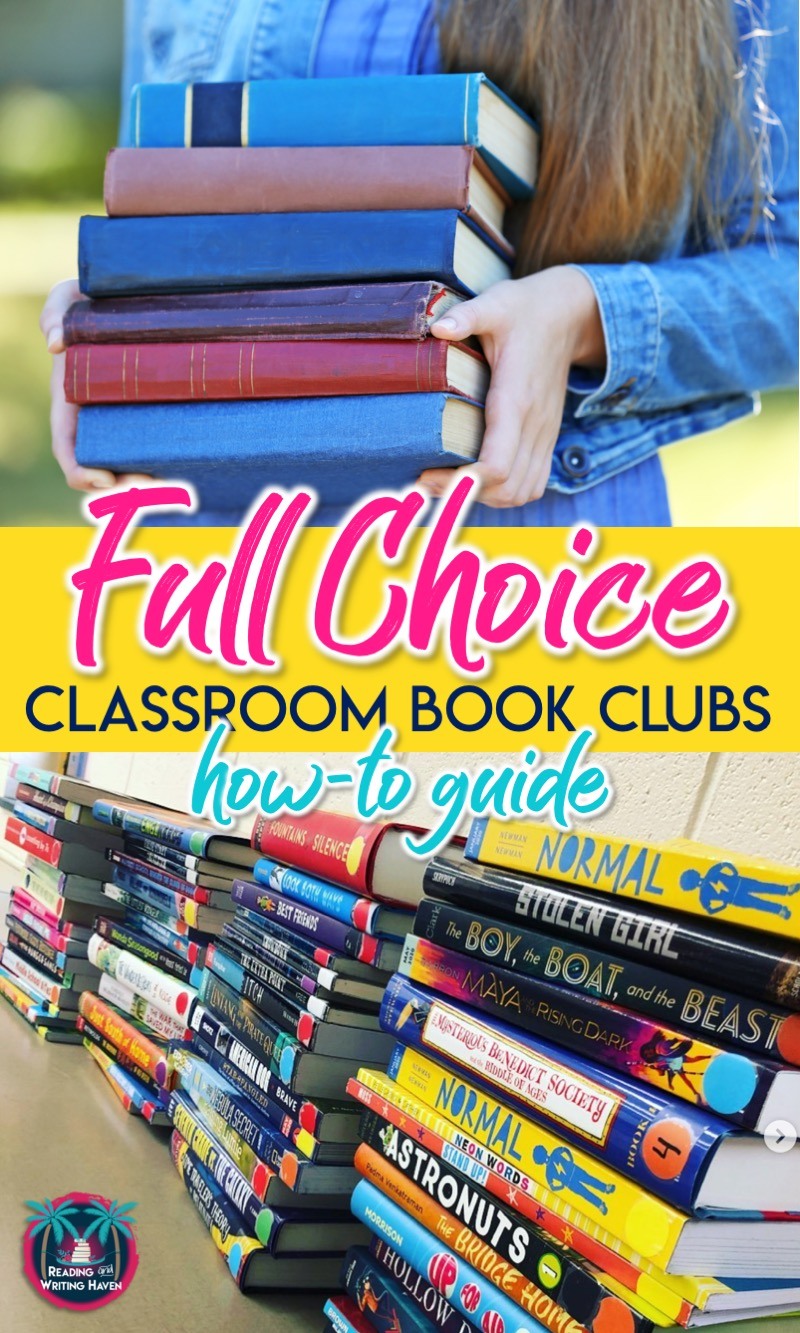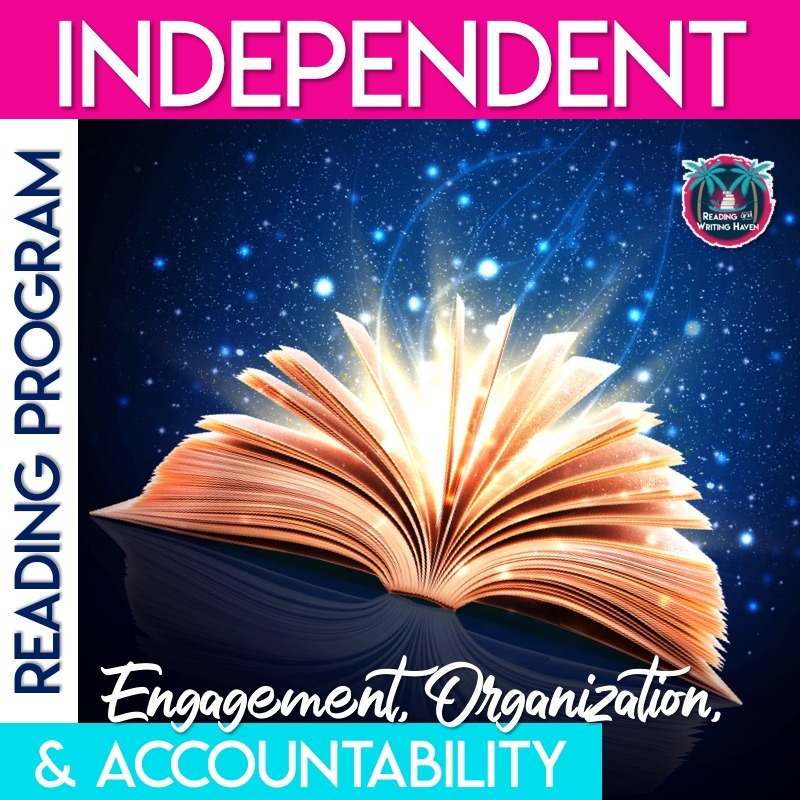How to Run a Full-Choice Book Club in Your Classroom: Independent Reading in Secondary
This post is the first in a three-part series about how to run a book club in your classroom. The second post details how to establish expectations and create a schedule, and the third post discusses accountability and assessment procedures.
Recent literacy research has revealed that choice is the key ingredient in a successful reading program, especially for reluctant readers. While this discovery is helpful (and also somewhat common sense), it leaves a lot to be desired in the classroom.
What are practical classroom implications for choice reading at the secondary level? Certainly, it can take a wide variety of forms, and no one practice is the correct answer. Five years ago after trying literature circles and independent novel studies (neither of which I necessarily loved or hated), I decided to try running a book club in my classroom.
Why does the book club model work? For one, it allows for choice. What’s more, it mimics real-life reading experiences. Reading is a hobby we want students to carry with them long after they receive their diplomas. Book clubs also provide the social enjoyment factor that students need to stay engaged with a text.
I’ve run a book club model with my classes for several years, and it’s been a practice that has transformed my students’ reading experiences. What I’m sharing with you worked for me in my setting under my given circumstances. I encourage you to use what you want and change what you need to in order to fit your situation.
DETERMINING THE GOAL
I recommend starting a book club at the beginning of the year. It’s always awkward to try something new later on because it doesn’t feel like a natural part of the class. Before beginning the book club experience, I sat down to determine the goal. What did I want students to get out of this venture?
I…
- …wanted them to enjoy reading (I wanted them to see reading as a hobby, not a chore.)
- …wished for them to think of reading as an extension of themselves…as a part of who they are.
- …wanted them to carry books with them wherever they went.
- …needed to connect the book clubs to the ELA curriculum and standards. But how?
In order to justify devoting class time to any particular event on a regular basis, I need to know I’ll be covering standards. Book club is no exception. After reading The Book Whisperer, I was inspired to structure my book club units around genres. Every month, we study a different genre of literature. Whenever possible, I tie the monthly genre in with the time of year. For instance…
- In September, we study the banned book genre (as Banned Books Week falls in September).
- During October, we study horror, mystery, and suspense (in keeping with Halloween).
- In February, we analyze realistic fiction (as many realistic fiction novels feature elements of romance).
Throughout the year, my students study reading strategies and literary terms, which are also simple to connect to our book club units through writing prompts and discussion questions.
Other options? You could gear each month’s book around a specific reading strategy or signpost and have students focus on, for example, connecting with or asking questions about their book that month. You could learn about plot one month, characters another, setting another, theme, etcetera, and then focus on those aspects of the books your students read during that time period.
BOOK ACCESS
It’s all fine and dandy to say you want to run a book club until you have to face the reality of finding the books. When you’re thinking about this issue, consider whether or not you have funding to purchase sets of books. If you do, go for it! The down side to this approach is that some students are still going to be forced to read a book that wouldn’t have been their first choice. This problem is what led me away from literature circles.
Are there other options? My solution to this one is pretty straightforward: Use your school library. Hopefully, you have a rockstar librarian like I do who keeps up with the most recent young adult literature, Abe Lincoln books, and student favorites. My students always check books out from the library. Once in a while, their parents will take them to the town library or purchase them a text from Amazon or a book store.
In my book club arrangement, all students are able to select different books. My number one goal is helping to pair them with a novel I think they’ll actually want to read. If you organize your meetings around genres or themes, students will still be able to have intelligent conversations about the unique texts they have each read.
Classroom libraries are a beautiful thing, but in order to effectively run a book club, you need more than a classroom library can provide, unless you are limiting students’ choices to a certain list of options. I have grown my classroom library over a long period of time. Some students do use books off of my shelves, but the vast majority find texts from the library.
GETTING BUY-IN FROM STUDENTS
In order for your classroom book club to be successful, you need to entice students. I begin with a reading interest inventory. I use this survey to gather information about my students’ previous experiences with reading as well as to get an idea of what type of books they enjoy. Throughout the year, this data helps me to find texts they might like. In addition, these conferring questions are great for talking one-on-one with students about reading. They help to build relationships.
In August (after I introduce the concept of our class book club), I teach students about literacy. Why it matters. What the implications are of not reading. What the benefits are of reading. I make sure they understand that reading is crucial to their success in life. Address the question of “Why does this matter?” by presenting a few facts each day.
The most successful strategy I’ve found for getting students to actually want to check out a book is to sell the novels through book talks. As I mentioned earlier, my school librarian is the bees’ knees. She reads books faster than I can walk to my classroom. So. I utilize her once a month. She comes in, gives book talks that would interest even the most reluctant of readers, gets the students excited about a novel, and then encourages them to come see her in the library to check out the novels.
The library is the heart of a school. If we want kids to enjoy reading, we need to make the library an inviting place they want to go…a place where they feel welcome. My successful experiences with book club are, in large part, due to the love and energy our school librarian dedicates to her space.
Finally, you’ll get much more buy-in from students if you’re passionate about book club. Make it fun. Read in front of them. Read with them. Explore the same genre as them. Read books they recommend to you. Talk about your book with them. It’s infectious.
MAKING TIME IN THE CURRICULUM
Many people would love to try running a book club in their classroom, but due to the rigorous standards and curriculum they must meet, they feel like it’s an overwhelming task. That was me.
Enrichment
But, then I started thinking about book club as an enrichment activity. It was something we would do to complement the other course work. No existing curriculum needed to be sacrificed to make room for book club. In real life, people read for pleasure in addition to their job, in addition to raising a family, and in addition to working out, cleaning their house, and cooking food. I didn’t want my students to perceive book club as something they had to “make time for.” Rather, I wanted them to see it as something everyone has time for if they make it a priority.
Standards
Plus, book club can enhance students’ growth toward standards. By conferring with students about their reading, you can support them with strategies they can implement with their books. Also, you’ll gather valuable information about trends in your room. Maybe a majority of the students need more work on character development. By conferring, you’ll know this, and you can be responsive.
The only time book club didn’t run in addition to course literature was if we were already reading a novel that demanded reading time outside of class. For example, To Kill a Mockingbird is a long book, and when we read it as part of our curriculum, students had nightly reading assignments. During this time, I made sure we were studying historical fiction as a book club, and if students wanted to, they could read a second historical fiction book on their own to complement TKAM, but I didn’t make them. Some did; other’s didn’t, and that was fine. I often have students reading more than one book at a time, and this situation is not much different.
Determining the purpose for running a book club, stressing the importance to students, accessing the books, and making time in the curriculum are just the first steps to getting a successful independent reading program off the ground. In the next post, read about how to establish expectations and create a schedule.
RELATED RESOURCES:
Click on the images below to view the independent reading program materials I use when I implement a book club in the classroom. These help me with engagement, accountability, and organization.



Thanks for all the thought put into this series! It’s so comprehensive…I feel like I could start it tomorrow and it would be a success.
Thanks, Marnie! You’re sweet. I definitely tried to cover all the basis. Book club is such a huge topic!
You’re welcome, Milana! Thanks for your encouraging words. 🙂